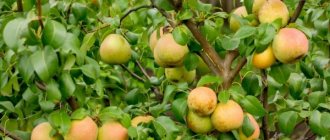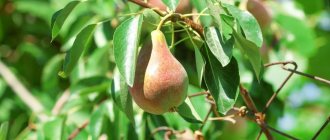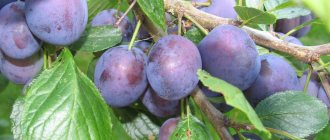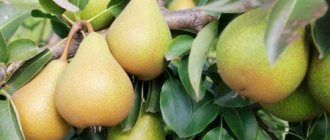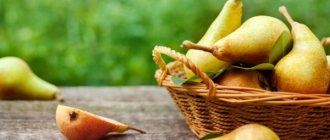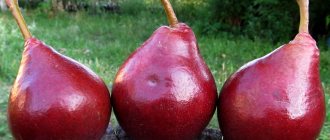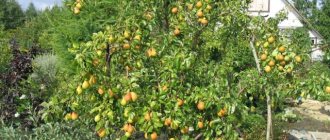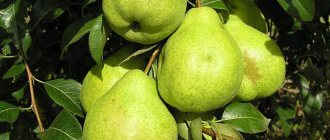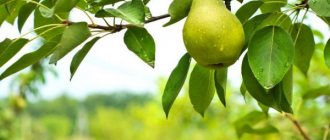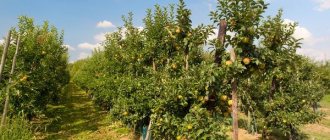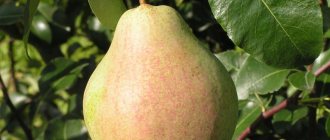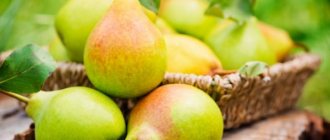Pear Bryansk beauty.
Description of the variety
The Bryansk beauty pear is one of the varieties of early autumn ripening. Thanks to its good hardiness, it is widespread in the gardens of the Central region and Central Russia.
Characteristics of wood
Trees of this variety have medium growth vigor. The height of an adult pear is 4-5 meters. The crown tends to thicken and has a pyramidal shape. The bark on the shoots has a dark burgundy tint. The leaves are dark green, medium-sized, and oblong in shape. The flowers are white, large.
Description of fruits
Pears are very large and weigh on average 250 grams. Some specimens can reach 450 grams. The fruits have a standard pear-shaped shape.
Bryansk beauty.
After ripening, the main color of pears becomes yellow. There is a beautiful burgundy blush on the surface. The taste of the fruit is sweet, with slight sourness and a pleasant aroma.
The harvest ripens in early September. The shelf life of picked pears in the refrigerator is about two months.
Characteristics of the Bryansk Beauty pear variety
Bryansk beauty is one of the few cultivars compatible with quince rootstock. The pear is characterized by good survival rate after grafting and planting the seedling in the ground. Selected variety with high immunity, stress-resistant. It withstands low temperatures well, but moisture deficiency can affect the growing season.
Drought resistance, frost resistance
After breeding, the variety was zoned under conditions of cold winters and relatively short summers. During experimental cultivation, the Bryansk beauty showed record results in frost resistance. Without additional insulation, the pear resists frosts down to -38 0C.
The fully formed root system of a pear is deepened within 60 cm; it cannot fully provide the tree with the moisture necessary for vegetation. Therefore, the Bryansk beauty consistently bears fruit only with sufficient water. Young seedlings have poor drought resistance and require periodic watering.
Pollinators
Bryansk beauty produces male and female flowers and cross-pollinates on its own, but other crop varieties located nearby will increase the yield. Fruit trees with the same fruiting period are suitable as pollinators for pears. The Bryansk beauty cultivar blooms in the second half of May, which means that pollinators with similar characteristics are selected for it. According to the reviews of experienced gardeners, Lada Amurskaya or Moskvichka pears planted nearby increase the yield of the Bryansk Beauty pear variety by up to 35%.
Productivity
The selection variety produces a harvest in 6-7 years of growth. After grafting or budding for the 3rd season, the first fruits are formed. For the Bryansk Beauty cultivar, the yield indicator is stable every year. The first fruits ripen at the end of August, the mass harvest takes place in mid-September. The level of fruiting is not affected by weather factors, the crop is stress-resistant, calmly reacts to temperature changes, and with timely watering it produces a good harvest.
Attention! A fruit tree produces an average of 18-20 kg of pears, with pollinators present up to 26 kg.
Application area
Bryansk beauty is classified as a dessert variety; the main use of the fruit is fresh consumption. The pear is stored for a long time; it does not lose its presentation and nutritional value for more than 15 days. The compact, medium-sized tree is cultivated in large areas of fruit and vegetable farms. Stable fruiting, transportability, and long shelf life make it possible to grow Bryansk beauty for commercial purposes. The fruits of the variety are universally used; they are processed into juice, jam, and jam. Wine is made at home.
Advantages and disadvantages
The pear has few disadvantages - it is average drought resistance and low yield without nearby pollinators. Basically, the culture is characterized positively; the advantages of the Bryansk beauty include:
- precociousness;
- stress resistance;
- high resistance to low temperatures;
- short stature, compact crown;
- stability of fruiting;
- high productivity;
- storage duration;
- transportability.
Reviews
Antonina
Yaroslavl
The variety is very good. In the first years, when the tree just began to bear fruit, there were few pears, but they were very large. Over time, the yield began to increase and the fruits became a little smaller. But, when compared with other varieties, they are still quite large.
Oleg
Cheboksary
When I bought the dacha, a pear tree was already growing on the plot. Overall the variety is good. The pears are very tasty, large and the harvest is always generous. But the main problem with the tree is scab. It is necessary to treat it several times a year, otherwise it immediately appears on both foliage and fruits.
Nikita
Snezhtsy
There are a lot of pears, this is a significant plus. It’s enough to leave them for the winter and roll them up in a jar. There are no complaints, the fruits are delicious, I am an unpretentious tree.
Diseases, pests, prevention
Despite the Bryansk beauty’s resistance to many pests, it also needs prevention.
Scab
Appears in cold climates with high humidity. For prevention, treat pears with copper sulfate before flowering. After fruit set, another treatment is needed with a product such as Gamair.
Powdery mildew
This disease can be recognized by a white coating that turns brown and then turns into black spots. Against powdery mildew, use Topaz or Spor. After harvesting, the tree must be treated with a one percent solution of Bordeaux mixture, and all foliage must be burned.
leaf roller
Leafworm caterpillars also settle in the kidneys. Therefore, you need to pre-treat all pears with Karbofos in a ratio of 30 grams per 10 liters of water. They also use tincture of tobacco, tobacco dust or shag.
Pear moth
Codling moth caterpillars, after hatching from clutches, gnaw tunnels in fruits and feed on seeds. A decoction of wormwood helps against them:
- 0.8 kilograms of dry grass should be infused for several hours in 10 liters of water.
- Boil the infusion for half an hour.
- Filter and add the same amount of water.
Trees are treated with this solution several times before flowering.
Landing
Proper preparation of the planting hole and planting the seedling are a very important component of the successful strengthening and development of the pear. Detailed instructions and tips on the technology and features of planting the Bryansk Beauty variety can be found in the articles selected below.
How to plant a pear tree correctly
At what distance to plant pears?
How to choose pear seedlings
How to replant a pear
Specifics of growing crops
Despite the high resistance of the variety to many factors, there are several features that are important to consider when planting. Also, not every seedling is suitable.
See also
Description and pollinators of the Belorusskaya late pear variety, planting and careRead
Place and time of landing
The best time to plant pears is early spring, before the buds open. Even if you bought seedlings in the fall, you can only dig them in, but it’s better to wait until they are transferred to a permanent place. The location for the Bryansk beauty is chosen taking into account the following requirements:
- Lots of light, since southern culture needs it to accumulate sugars.
- The aquifer is no closer than 2.5 meters, otherwise the roots will rot.
- The soil is fertile, light, breathable, slightly acidic or neutral.
Although the variety is undemanding to pollinators, the presence of suitable trees will allow you to obtain constant and rich harvests. The main thing is that they grow up at the same time as the Bryansk beauty. Ideal options are Moskvichka and Lada Amurskaya.
Selection of seedlings
When choosing planting material, pay attention to the appearance of the seedling and some other features:
- age – no more than two years;
- well-developed, healthy root system 30 centimeters or more in length;
- plant height – up to 70 centimeters;
- no signs of disease or damage.
Such a seedling will take root well in a new place and will soon produce its first harvest.
Correct fit
Before planting, it is important to prepare the seedling and the place for it. To do this, keep the pear roots in Kornevin solution for about 40 minutes. Then they dig a hole measuring 75x100 centimeters, and from the removed layer they make a mixture, adding organic matter and 120 grams of superphosphate and potassium.
The landing itself proceeds as follows:
- Bury a stake at a distance of 15 centimeters from the center of the hole.
- Pour some of the soil mixture into a mound.
- Place the seedling in the hole, distributing the roots along the bottom of the hole. If there is a lump of earth, save it.
- Place the rest of the soil on top.
- Tie the seedling to a stake, then compact the soil and water.
If you plant Bryansk beauty in the spring, then it must be shortened, then the plant will produce more side shoots.
Care
An adult tree does not need special care, but a young seedling should be given more attention in the first years after planting. Recommendations for growing and caring for the Bryansk beauty can be found by clicking on the links below.
How to care for a pear Pruning a pear Pruning a columnar pear Treating a pear from diseases and pests Feeding a pear How to water a pear
History of selection
The Bryansk Beauty pear variety got its name for a reason. She was bred near the city of Bryansk. Breeder N.I. Rozhnov discovered a new product, the merits of which were appreciated by many breeders. To this day, no one knows the history of the discovery of this variety.
It is believed that varieties such as “New Year” and “Williams Red” were used during selection. Initially, the variety was bred specifically for the Black Earth Region, but very quickly became popular in many other regions. The pear spread throughout the central part of Russia, including reaching the Urals.
Diseases and pests
Pear is not resistant to scab and many other diseases, so it requires regular preventive measures. Useful materials on how to protect the Bryansk beauty from pests and diseases can be found by clicking on the links below.
Dangerous Pear Pests
Pears often suffer from pests, they affect the leaves, bark and fruits.
In this article, we have selected 11 of the most harmful insects that harm pear trees, and also ways to destroy them.
Diseases of pear trees
To get what they cherish, gardeners have to work hard, and the reason for this is pear diseases.
Read about 19 common pear diseases and how to combat them.
Reproduction methods
Bryanskaya Krasavitsa pear seedlings can be grown from seeds or obtained by grafting. In addition, you can graft individual cuttings onto other varieties of pears or quinces.
A pear grafted onto a quince is characterized by short stature, begins to bear fruit early and produces sweeter fruits. However, frost resistance is lost.
Seeds for pear propagation are harvested only from ripe fruits. They are washed, placed in damp gauze, and then planted in a prepared container with soil.
Cuttings are obtained from healthy, young, actively growing fruit-bearing trees. They are cut from October to March, when sap flow is weakened. Cuttings are grafted onto the rootstock in various ways: in the butt, in the cleft, under the bark, by copulation, improved copulation and budding.
Agricultural technology
Selection of location and soil
A review of the growing features should begin with the requirements that apply to the soil of the area allocated for this type of pear.
Place to plant a pear
The site requirements are as follows:
- The planting area for pear crops should be spacious enough and not shaded by other trees.
- The depth of underground (ground) water should not be less than 3 meters (the presence of stagnant moisture leads to rotting of tree roots).
- For this plant, slightly acidic (or at least neutral) soil is preferred.
The pear variety in question is a self-fertile crop, a good harvest of which is not at all guaranteed. The volume of fruit harvest in this case is determined by local factors, namely: climatic conditions and soil quality.
To increase the number of fruits, it is preferable if some kind of pollinating tree grows next to the Beauty. When choosing, you should proceed from the fact that its flowering time approximately coincides with the same period for the pear. Crop breeding practice has shown that with an increase in the number of trees growing nearby, the likelihood of cross-pollination increases, which leads to an increase in the yield of each of them.
Planting a pear
Planting seedlings of this species in the ground can be done at any time of the year (spring-summer-autumn). The main condition for successful cultivation is to prepare the soil at the planting site in advance (dig holes in it and wait until the soil settles completely).
When preparing a planting site for the Bryansk beauty pear, the fertile soil is laid out separately, which allows you to subsequently mix it with 2-3 buckets of manure (compost), and then add another bucket of river sand to the resulting mixture. A glass of superphosphate and about 5 large spoons of potassium sulfate should also be added there. The resulting composition is thoroughly mixed, after which the previously dug hole is filled with it.
Planting a pear seedling is carried out according to the following scheme:
- A small mound is made in the center of the previously prepared hole, raising the root collar of the sprout a few centimeters above the ground level.
- A peg is driven in next to it, which will later be used to tie up the pear tree.
- After this, the pit is covered with soil, which is then thoroughly compacted.
Watering pears
Upon completion of the excavation work, the planting site is watered with 2-3 buckets of well-settled water. Immediately after the water is completely absorbed into the soil, the soil around the pear seedling is mulched (compost or wood shavings can be used for this).
Care
Throughout the growing season, a pear seedling needs regular watering of the tree trunk and regular weeding. Starting from the second year of cultivation, various fertilizers are added to the soil underneath, and measures are also taken to counteract diseases and garden pests.
In the summer, to water a young seedling, it is preferable to use a special mode called sprinkling, which involves spraying through a hose using a special nozzle-splitter. In its absence, water is simply poured into a groove dug along the circle with a depth of about 10-15 cm.
After watering is completed and moisture is finally absorbed, the soil under the tree must be loosened. The next feeding is applied to the seedling only next spring. It contains mandatory mineral fertilizers (30-40 grams of superphosphate, 20 grams of potassium chloride and a little urea). Once a year, organic matter is added to the same area in a specially prepared ditch, including humus, compost and slurry or chicken droppings (up to 10 kg in the mixture).
To protect pear seedlings from severe winter frosts, it is recommended:
- Thoroughly mulch the area around the trunk.
- Wrap it in thick paper, a piece of roofing felt, or insulate it with fir branches.
- Thoroughly hill up the tree, pouring an additional earthen ball up to 0.5 meters thick under it.
In winter, it is recommended to shovel freshly fallen snow onto the area under the seedling.
Fertilizer for pear
Advantages and disadvantages
After such a detailed description, we should summarize some results, thanks to which we can clearly see why this pear is so loved, and what qualities it has that are not so shining.
We also relied on reviews from experienced and truly knowledgeable gardeners, which, by the way, were most often extremely positive.
Among the advantages of this variety, experienced gardeners highlight the following characteristics:
- Productivity. It's really quite good, especially for a relatively small tree. With proper care, it is quite possible to harvest sixteen kilograms of pears from one square meter of plantings, which will also last until March.
- The flowers open at different times. For beginners, this plus will seem completely unobvious, but it is very important, especially when it comes to approaching frosts and snowstorms.
- On average, fruits begin to appear already in the third year after planting. However, if you are a beginner, this period may extend to four years, and therefore you should not be surprised at all.
- In addition to the fact that the plant is very well protected from winter frosts, it is also practically not afraid of droughts and survives very well during periods when there is little water.
- The variety is unpretentious, which, of course, is very important for those gardeners who are just starting their journey to growing large trees that require an eye and an eye for.
- As we have mentioned more than once, many note the extremely long storage of fruits, which benefits not only those who want to enjoy the fruits in the spring, but also those who sell pears. By the way, a huge advantage for them is both the size and marketable appearance, as well as the taste of the fruit, which only improves over time.
- The fruits are extremely easy to transport, load and unload, making them even easier to handle from a trading perspective.
Of course, there are obvious disadvantages of this variety, among which are the following:
- This variety, like almost any pear, is completely unstable to bacterial burns and infection by such an unpleasant disease as scab. These weaknesses are especially evident in damp summers.
- If the number of fruits increases significantly, their size and, to some extent, taste decrease. Therefore, the size of the crown must be constantly closely monitored.
- This plant requires the presence of pollinators, which, of course, adds trouble to the gardener. The best pollinators of the Belorusskaya late pear will be the following varieties: Conference or Bere Loshitskaya.
Otherwise, the Belorusskaya late winter pear variety is still extremely good, and we, without going back on our words, continue to recommend and praise it. Now that we have understood absolutely all the characteristics and features of this variety, and you are very familiar with it, we can proceed directly to the planting procedure.
Pear fruits and fruiting
Fruit characteristics:
- taste - sour-sweet, with a light aroma;
- shape - elongated, pear-shaped, with tuberosity present;
- peel – medium thickness, there is a slight waxy coating;
- the pulp is white, slightly oily, dense and juicy;
- color - when ripe, the fruits are greenish, with slight redness; when ripe, they become greenish-yellow with a red-brown blush;
- seeds are elongated, brown.
The fruits contain:
- sugar – 9.8%;
- vitamin C – 5.7 mg per 100 g;
The variety maintains active fruiting for 30 years. And the lifespan of a tree is about 50 years. Life expectancy and ability to bear fruit depend on agricultural technology. The average yield per tree is 120-140 kg per year. Can reach 200 kg per tree.
Diseases and parasites
The variety is resistant to diseases and parasites, so gardeners can save time and effort on treating the tree. But you should always remember about preventive measures that do not allow the plant to be exposed to negative environmental influences.
- Watering should be normalized. The more moisture that enters the roots, the greater the likelihood of root rot.
- To protect the plant from parasites, it should be sprayed in the spring with a 1% solution of Bordeaux mixture.
How to protect a pear and prepare it for winter
Despite the fact that the late Belarusian pear has a fairly reliable and strong immunity, which perfectly protects it from all kinds of insects, bacteria and viruses, it should still be treated with fungicides that prevent scab infection. The fact is that fighting this disease if it has already arisen is an extremely problematic task, and therefore it is much better to try with all our might to prevent its appearance at all.
As you already know, this variety is very well protected from frost and wind, but, nevertheless, in our harsh conditions it is still very difficult for it to survive the winter, and therefore, if you want the plant not to die during the cold weather, you need provide adequate protection.
First of all, you need to protect the root collar and the root part of the trunk from the cold, and therefore you will have to resort to using a large amount of mulch. Even if it is already lying near your tree, it is advisable to increase its quantity and also compact it.
It is also advisable to wrap the trunk with special garden fiber, which will protect it from frostbite at extremely low temperatures. This is done up to a height of one to one and a half meters above the ground.
Caring for Belorussian late pear
Caring for a pear consists of forming the crown and sanitary pruning, watering and fertilizing, preparing the tree for wintering, and preventing diseases.
Trimming
The first pruning should be done immediately after planting. A one-year-old seedling is shortened to a height of 60–70 cm. In two-year-olds with rudiments of skeletal branches, all shoots are cut off by 1/3. Pears are not prone to thickening, so further care of the crown consists of not letting the tree grow upward. To do this, shorten the central shoot by 1/4, causing lateral branching.
Every year, branches growing inside the crown, as well as broken, dried out, diseased shoots are cut out. Growths are shortened by 1/4 of the length to speed up the formation of flower buds.
Video: pruning a young pear tree
Watering a pear tree
The pear tree must be irrigated regularly, especially in the first years of a young tree’s life, until the central root has grown a sufficient number of lateral roots. You need to water once a week in the morning or evening, 1 bucket per plant. Water is poured into a furrow dug around the perimeter of the tree trunk.
With the onset of fruiting, at certain periods the tree requires more moisture. The first abundant watering is carried out before flowering. The second is during fruit set. Pour 2-3 buckets of water under the tree. The older the plant, the more moisture is required for the roots. Currently, the problem can be solved by installing drip irrigation.
The problem of delivering moisture to tree roots can be solved by installing drip irrigation in the garden.
Fertilizers
Pear loves nitrogen more than other pome crops. But it is not at all necessary to apply chemical fertilizers.
In the 1st century AD, the famous Roman philosopher Pliny described 41 varieties of pears. But in those days, there were no fertilizers other than ash, bone meal, manure and bird droppings. Therefore, fertilizing with natural means is quite enough for this crop.
Before fruiting begins, the pear is not fed anything for the first two years. Then the tree needs to be fertilized annually. Fertilizing should be applied after abundant watering of the trees.
Table: feeding pears
| Period | Feeding composition and quantity for 1 tree |
| After the snow melts | Deciduous tree ash - 1 kg + 300 g bone meal for digging around the perimeter of the tree trunk circle |
| Tying buds (choose one of the dressings) |
|
| During fruit set (one of the top dressings to choose from) | |
| At the beginning of August | Deciduous tree ash - 1 kg around the perimeter of the tree trunk |
| After harvest | Deciduous tree ash - 1 kg + 300 g bone meal + 2 buckets of humus or compost for digging the tree trunk circle |
Tree trunk care
The health of a tree and its productivity often directly depend on the condition of the tree trunk. Pear does not like sodding. You can only plant low-growing lupine around the perimeter of the crown, which retains nitrogen in the soil.
To retain moisture in the ground, the pear tree trunk is mulched. It also provides additional nutrition. Any organic matter is suitable for this purpose: peat, rotted sawdust, mown and dried grass, sunflower husks, pine nuts, etc. The thickness of the mulch layer is at least 7–10 cm.
Mulching the pear tree trunk with cut grass protects against weeds, retains moisture, and provides additional nutrition
Spring and autumn work
- Immediately after the snow melts, they dig up the tree trunk circle, introducing the necessary fertilizing.
- Formative and sanitary pruning of the crown is carried out.
- In autumn, fallen leaves are raked and burned.
- Remove and destroy all fruits remaining on the branches, especially mummified or rotten ones.
- They dig up tree trunk circles.
- Trees are sprayed against diseases and pests both in autumn and spring.
- The trunks and bases of skeletal branches are whitened with a composition of lime with the addition of copper sulfate.
- It is not recommended to whitewash trees under 4 years old. Instead of whitewashing, the trunks of young pears are wrapped with special tape to protect them from frost damage and rodents. The trunks are also protected from the latter by spruce branches, which are strengthened around the trunk.
It must be remembered that tying the trunks can only be done after the wood has been prepared for winter, i.e. in late autumn, when frosts are below -2°C.
The pear trunk, protected with a special tape, is not afraid of temperature changes
general information
We can say with a high degree of confidence that the ancestors of the Bryansk pear variety were New Year’s and another well-known species, Williams red.
This hybrid was intended specifically for the Black Earth regions, but over time it quickly spread across the vast expanses of Russia, including the Ural region. Additional information: the latter is explained by the fact that at one time specialists from the Orenburg Research Station (Southern Urals) were involved in the selection of this pear.
This pear variety needs a lot of sunlight for its normal development. When choosing a landing region, you should proceed from the fact that there are no strong winds in the area.
Bryansk beauty
This is interesting: How to make and what are the benefits of dried bananas - in general terms
Features of harvesting and storage
Ripening of Russian Beauty pears begins at the end of August, and its exact timing depends on the climatic conditions of the region. You can collect the fruits at the stage when their peel turns greenish-yellow, or you can leave them on the tree until the first half of September so that they acquire a characteristic blush.
Basic rules for collecting and storing fruits:
- Harvesting is carried out in dry weather;
- For better storage, it is recommended to pick fruits slightly unripe;
- pears are removed from the tree along with the stalks - this increases the shelf life;
- fruits are handled very carefully, protecting them from mechanical damage and shock;
- whole fruits are stored in boxes, placed in 2-3 layers and separating each of them with layers of paper;
- fruits are stored in a dark room at a temperature of 0 ... + 1 ° C and a relative humidity of 94%.
It is recommended to remove the fruits of the Russian Beauty pear at the moment when the skin begins to turn yellow - this indicates that they have reached their best taste.
In the right microclimate conditions, pears can be stored for up to 3 months. Ripe fruits can be used fresh, as well as for making desserts and canned preparations.
The Russian Beauty pear is grown in many garden plots, providing gardeners with a harvest of sweet fruit every year. Using the recommendations for caring for the crop listed in the article, you can plant and successfully grow this variety on your own plot.
